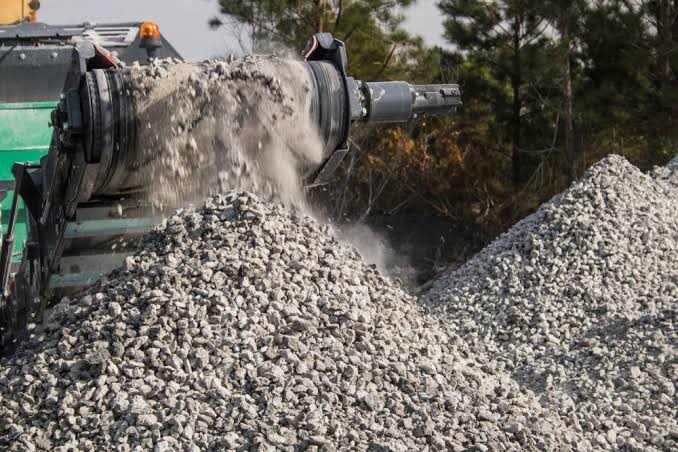Concrete recycling is an environmentally friendly practice that repurposes unused concrete from construction projects rather than disposing of it. This process not only conserves natural resources but also reduces waste, helping to protect our environment. This is a great way to make our future better.
This article guides you through concrete recycling. We’ll talk about how concrete gets a new life after being used. You’ll learn about the good things that happen when we recycle concrete. Also, the many ways we can use recycled concrete.
Do you want to know more about recycling concrete? Or maybe you’re interested in using leftover concrete in new ways? You’re in the right spot. Let’s explore how concrete recycling can be both friendly to the earth and budget. It’s full of solutions we need to know.
What is Concrete Recycling?
Concrete recycling involves transforming unused concrete from construction sites into new materials. The process typically begins with crushing the leftover concrete into smaller pieces using specialized machinery. During this process, any contaminants such as dirt or debris are removed, ensuring that the concrete is clean and safe for reuse.
It helps the earth and the building world in big ways. There is less waste in landfills and less harm to our planet. Plus, it saves money by using old materials instead of buying new.
This also brings more job chances in construction. As recycled concrete is more used, so are the people who know how to work with it.
Concrete recycling is key to building in a way that’s good for the future. It makes sense for the wallet and the environment at the same time.
How is Concrete Recycled?
- Crushing: Large machines with powerful jaws and impactors crush old concrete into small bits and granules. This initial crushing breaks the concrete down into manageable pieces necessary for further processing.
- Further Crushing: The crushed concrete undergoes additional crushing stages to eliminate any remaining dirt. This step is crucial to ensure the cleanliness and safety of the recycled concrete.
- Sorting: After crushing, the concrete is sorted by size using machines. This sorting process is vital for creating strong, new concrete suitable for construction.
The meticulous removal of all dirt and debris is essential in this process. By employing robust machinery and thorough techniques, the final product is high-quality recycled concrete, ideal for building new structures.
Recycling concrete not only supports sustainable construction practices but also provides a cost-effective solution for managing construction waste. This approach not only benefits the environment but also contributes to the creation of durable, new materials from what would otherwise be considered waste.
Ways to Repurpose Concrete / Benefits of Repurposing Concrete
Repurposing concrete helps our environment and the building world. It cuts down on waste and lessens what we throw away. This makes it great for the planet. Also, concrete lasts a long time.
It might take up to 50 years for big pieces of concrete to break down in a dump. But, if we use concrete again for new things, we help the earth. We lower the bad effects of trash from building work.
Reusing concrete not only benefits your wallet by saving money—since there’s no need to buy new concrete—but it also provides more employment opportunities in the construction sector, helping the economy grow.
Recycling old concrete into new, aesthetically pleasing structures like paths, driveways, and patios not only helps the environment but also promotes more sustainable construction practices. It makes our future better. And it makes sense too, saving us money and creating jobs.
The Uses of Recycled Concrete
Recycled concrete helps with green building and saving the environment. It is used in many ways. Let’s look at some important uses.
Paving for Residential Properties
Recycled concrete is often used for paving in homes. It makes beautiful driveways, walkways, and patios. This option saves money, is strong, and lasts long. It’s good for the planet too.
A Sturdy Base for Asphalt Paving
It’s a great base for laying asphalt. Crushed concrete replaces gravel, cutting down on new material use and transportation. This saves nature and lowers the pollution from building.
Building New Oceanic Reef Habitats
Big pieces of recycled concrete support oceanic reefs. They help coral grow and make homes for sea creatures. It’s a smart, eco-friendly approach to building marine life homes.
Repairing and Reinforcing Water Banks
It helps fix and protect water edges. Crushed concrete stops soil from washing away. This keeps our water sources healthy. It’s a solid, earth-friendly choice.
Recycled concrete is key for earth-friendly construction. It brings a green touch to many projects. From homes to saving ocean life and water banks, it does a lot. Using recycled concrete helps build a better, greener tomorrow.
Want to rejuvenate your concrete?
If you’ve recently completed a construction job and have leftover concrete, there are several ways you can handle it:
- Local Landfill: You can take your concrete to a local landfill that has specific areas designated for concrete disposal. This ensures the concrete is processed correctly, typically being crushed for recycling.
- Debris-Removal Service: For large quantities of concrete, consider hiring a debris-removal service. These services are knowledgeable about proper disposal methods and can help repurpose the concrete in an environmentally friendly manner.
- Online Selling: Another option is to sell your leftover concrete online. Contractors and DIY enthusiasts often look for such materials for their own projects. This not only helps the environment by recycling materials but also fosters community interaction over shared resources.
- DIY Projects: If you’re crafty, you might find a new use for the concrete yourself. By repurposing the concrete, you not only recycle it but also give it a new life, which can be incredibly fulfilling and environmentally beneficial.
Each of these options offers a responsible way to deal with leftover concrete while contributing positively to environmental sustainability. That’s good for the planet.
It’s really important to handle concrete waste the right way to keep the environment safe and avoid fines. Pick the way to recycle your concrete that works best for you and is good for the planet.
How is Concrete Recycled?
Concrete recycling involves various methods that reduce waste and enhance sustainability in the construction industry.
Crushing Concrete
One effective method of recycling concrete is by crushing it into smaller pieces. This process is facilitated by large machines such as jaw crushers, which break down large concrete blocks into manageable sizes. This step makes the concrete smaller and ready for more work.
Chemical Processes
Another method is to use chemicals to break down the concrete. Chemicals like sulfuric acid can be used. They make the concrete paste react and break down. This way is good for big concrete structures. And you don’t need huge machines around.
Both crushing and using chemicals can recycle concrete. It’s a green way to deal with leftovers from building sites.
Benefits of Repurposing Concrete
Repurposing concrete is good for building, the earth, and money. It helps by using less new stuff and saving a lot. Let’s look into why it’s great to reuse concrete:
Cost Savings
Recycling concrete saves a lot of money for building. Instead of buying new, using old concrete cuts costs. This method is particularly beneficial for large construction projects that require substantial amounts of concrete.
Reusing concrete eliminates the additional costs associated with disposing of waste material. You avoid expenses related to dumping and storage, making the construction process both cheaper and more efficient.
Job Opportunities
Recycling concrete also means more jobs in construction. People are needed to handle the old concrete right. This includes using machines, sorting, and checking the crushed concrete.
More companies are focusing on recycling concrete. So, this creates more jobs overall.
Community and Environmental Benefits
Recycling concrete significantly benefits both the community and the environment. It reduces the amount of waste sent to landfills, thereby saving space and decreasing pollution. By opting to use recycled concrete over new concrete, the construction industry can lessen its environmental impact. This practice conserves energy and natural resources, contributing to a reduction in the overall carbon footprint.
Overall Impact
The reuse of concrete isn’t just about cutting costs or creating employment opportunities; it’s a step towards a more sustainable world. It reduces waste and optimizes resource use in construction, aligning with broader environmental goals and helping to build a greener planet.
The Uses of Recycled Concrete
Recycled concrete has many uses, making it a key material for building things. It’s perfect for different projects like making paths or shoring up riverbanks. And it’s great for the planet too.
Paving for Residential Properties
Recycled concrete is perfect for making paths and driveways at home. It looks good and lasts long. By picking recycled concrete, you’re saving money and helping the earth.
Repairing Water Banks and Erosion Control
It’s also good for fixing up river edges. Recycled concrete helps keep our waterways safe by stopping erosion. It’s a big win for nature and keeping our water systems healthy.
A Base for Asphalt Paving
This concrete works well under asphalt too. It makes a strong base for roads and places where you need a tough surface. Using recycled concrete saves money and is better for the environment.
Environmental and Economic Benefits of Recycled Concrete:
- Resource Conservation: Using recycled concrete helps conserve natural resources by reducing the need for new concrete.
- Waste Reduction: It decreases the amount of waste that would otherwise contribute to landfill overflow.
- Cost-Effective: Recycled concrete is a cost-effective alternative for many construction projects, offering durability without the high expense.
- Sustainable Construction: It supports green building practices, potentially aiding in obtaining LEED certification and meeting other environmental goals.
Practical Applications in Construction
Recycled concrete proves to be a versatile and sustainable material, suitable for foundations, walls, and floors. Its strength compares well to new concrete, making it a viable option for builders and architects. By lowering the demand for new concrete, recycled materials help pave the way toward greener building techniques.
It shows a dedication to caring for the environment by those in the construction field.
In any building project, whether a home, business, or big public work, recycled concrete is important. It saves money and the planet, making sense for those who build with the future in mind.
Landscaping Projects
In landscaping, it’s smart to use recycled concrete for certain projects. This helps make your work sustainable and good for the environment. You can use it for walls, paths, and bordering gardens.
Recycled concrete is a good choice because it saves money and lasts a long time. Choosing recycled concrete is a win-win for the environment, economy, and construction industry. It aligns with sustainable practices, enhances project affordability, and supports the transformation of old materials into new opportunities.
This approach not only ensures that your projects remain beautiful and robust over the years but also contributes significantly to ecological conservation. This choice matches the need for earth-friendly landscaping.
Moreover, this method can help your project earn green certifications. It shows you care about the planet’s health. Choosing recycled materials is a big step in making the world a better place.
Conclusion
Recycling concrete is key in green building. It cuts waste, saves resources, and lowers costs. This good practice also means less filling up of landfills.
It helps cut down on making new concrete, lowering its carbon footprint. Using recycled concrete benefits our planet in many ways. It’s good for roads, buildings, parks, and saving nature.
Choosing green building methods makes a big difference. It helps our earth, money, and our neighborhoods. Working together, we can make our world better for those who follow.



